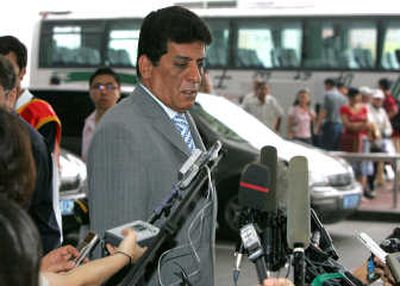N. Korea reactor shut down

SEOUL, South Korea – A North Korean diplomat confirmed that his country had shut down its sole operating nuclear reactor after receiving an initial shipment of oil aid and said U.N. inspectors would start verifying the closure today.
If confirmed by the U.N. inspection team, the shutdown would be the North’s first step in nearly five years toward de-nuclearization, one that comes after lengthy international talks.
“Immediately after the arrival of the first heavy fuel oil, the facilities were shut down and the (International Atomic Energy Agency) personnel will verify that maybe by now, or from today in Korea,” said Kim Myong Gil, minister at the North’s mission to the United Nations in New York.
Saturday’s delivery of 6,200 tons of heavy fuel oil from South Korea was the first of 50,000 tons promised to the North in exchange for shutting down its reactor in a deal with the United States, China, Japan, South Korea and Russia. Pyongyang will eventually get 1 million tons of oil and other financial and political concessions.
After tortuous negotiations and delays – during which the North argued its nuclear program was needed for self-defense – the reclusive regime said earlier this month that once it received the oil shipment, it would consider halting its reactor.
In Washington, the State Department said Saturday that North Korea had told the United States the reactor had been shut down, hours after the oil arrived in port.
“We welcome this development and look forward to the verification and monitoring of this shutdown by the International Atomic Energy Agency team,” State Department spokesman Sean McCormack said in a statement.
The 10-member IAEA team arrived in the North Korean capital Saturday afternoon. Team chief Adel Tolba said the inspectors would stay in North Korea as long as needed to complete their work at the Yongbyon plutonium-producing reactor, located about 60 miles northeast of Pyongyang.
“We are going directly to the nuclear site at Yongbyon,” Tolba told broadcaster APTN outside the airport.
Footage showed dozens of cardboard boxes being loaded onto the back of two trucks. It was not immediately clear what they contained but Tolba earlier said he and his colleagues were bringing 2,200 pounds of equipment for use during the trip.
After the IAEA team installs monitoring equipment, some experts will remain at Yongbyon to ensure the reactor stays shuttered, said a diplomat familiar with North Korea’s file at the IAEA.
“The IAEA plans to have a permanent presence there, with some experts remaining at the site continuously,” said the diplomat, who requested anonymity due to the issue’s sensitivity.
Kim said the next steps would include the North declaring its nuclear program and disabling the facilities. But he said that would happen only if the U.S. took actions “in parallel,” including removing wider economic sanctions against North Korea and striking it from a list of states that sponsor terrorism.
“After the shutdown, then we will discuss about the economic sanctions lifting and removing of the terrorism list. All those things should be discussed and resolved,” Kim said.
The six-party agreement eased a standoff that began in October 2002, when the U.S. said North Korean officials had admitted having a secret uranium enrichment program. Washington said that violated a 1994 agreement for the North’s disarmament, and a month later halted oil shipments under that deal.
The North reacted by expelling IAEA monitors, withdrawing from the Nuclear Nonproliferation Treaty and restarting the reactor.